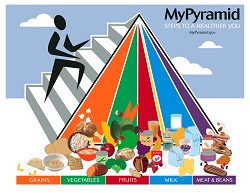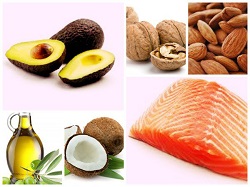Brenda Wollenberg BSW RHN is a specialist in natural wellness programs for children, teens and adults, has been featured on TV and podcasts, and is author of Overweight Kids in a Toothpick World, a practical manual for families dealing with childhood obesity. She recently redefined the path to both family and adult wellness by creating In Balance Wellness and Weight Release Programs (inbalancelm.com), safe, simple and sustainable systems that combine home learning modules, weekly online support and weekend live intensives. Her decades of experience as a social worker, pastor and nutritionist allow her to uniquely and compassionately share on body, mind and spirit wellness. All of it, however–the passion for health, the teaching and the learning–started at home with her husband, Mark, and their amazingly wonderful five children.
 While having a shorter history than the Egyptian pyramids—as well as less tourist traffic and movie exposure—the USDA MyPyramid and its Canadian counterpart food guide have definitely been around for awhile. Elementary schools prominently display large colorful food pyramid or food rainbow posters and high school food/nutrition classes will probably have at least one question on the food guide in their exams. Since they were developed in the 1950s, governmental food guides have been an apparent bastion of wise counsel; and to those that followed their guidelines came an inherent assurance of good health.
While having a shorter history than the Egyptian pyramids—as well as less tourist traffic and movie exposure—the USDA MyPyramid and its Canadian counterpart food guide have definitely been around for awhile. Elementary schools prominently display large colorful food pyramid or food rainbow posters and high school food/nutrition classes will probably have at least one question on the food guide in their exams. Since they were developed in the 1950s, governmental food guides have been an apparent bastion of wise counsel; and to those that followed their guidelines came an inherent assurance of good health.
Unfortunately, however, following the recommendations of food guides has not always produced expected results. Some opponents were concerned about the high amount of dairy products and carbohydrate-rich foods recommended. Others felt the reasons for North America’s increased obesity rates and mounting health problems were the food guide’s insufficient emphasis on vegetable intake, its “everything in moderation” stance on sugar or the fact there was little or no allowance for different body types.
A quick look around the neighbourhood is all it takes to show that North Americans are not all alike. We each have a particular heritage and a unique set of genetic material. It seems highly unlikely, therefore, that one certain triangular or rainbow-shaped way of eating is going to produce optimal health in everyone.
And now, with a recently published Report of the Standing Senate Committee on Social Affairs, Science and Technology on Obesity in Canada, many of those opponents—both to what is included in the food guide and its “one-size-fits-all” approach—have been shown to be on the right track! Though there were many questionable practises brought to the light in the report, perhaps the most damning points of all were made with regard to Canada’s food guide—a guide very similar in make-up to the MyPyramid .
The food rainbow was last revised in 2007; 4 of the 12 panel members responsible for the revisions were at the time employed in the food industry, by corporations that would, it is believed, be very affected by the guide’s recommendations. The Standing Senate Committee’s conclusion?
“Canada’s food guide has been at best ineffective, and at worst enabling, with respect to the rising levels of unhealthy weights and diet-related chronic diseases in Canada.”
And we at In Balance (IB), with a long history of creating and facilitating natural wellness and weight release programs, agree! Bottom line, we like a lot of what committee members intimated in their report . . . because it works.
The five Back to Basics principles we teach in our wellness and weight release programs fall in line with recommendations coming out of the Obesity in Canada report. The nice thing, however, is they won’t take you 56 pages of fairly intense reading to grasp and are simple enough to be applied anywhere, at any time. And no matter age or current degree of wellness, they are a good foundation to increasing the health and well being of almost anyone.
- Minimize refined foods like white flour and sugars.
The past 50-60 years’ worth of consumption of refined grains and sugars has contributed to a loss of essential nutrients, which in turn leads to a variety of other ailments including obesity and digestive disorders. Short term, sugar and refined grain intake can cause fatigue, weight gain, arthritis and depression. Long term, the list of potential ailments includes dental cavities, heart disease, yeast overgrowth, hypertension, hypoglycemia and emotional illness. Moving these less than helpful foods out of your daily diet and relegating them to a rare Sometimes Foods appearance is one of the best things you can do to reach and maintain health and wellness.
- Eat enough good quality protein-rich food.
Upon completion of our intake forms, most of our program participants discover they are eating too many carbohydrate-rich foods (i.e. cereals, breads, pastas, crackers, sugars, potatoes, rice and even fruit) in proportion to protein-rich foods (i.e. red meat, chicken, lamb, turkey, fish, legumes, nuts, seeds, eggs, cheese, high quality protein powders). Most food charts, too, place a major emphasis on eating large amounts of grain-based foodstuffs at the expense of sufficient recommendation for protein foodstuffs.
Protein-rich foods supply a wide range of nutrients and, equally important, help to balance blood sugar levels and insulin production.
- Get enough healthy fat.

“Wait a minute,” you might say; “I thought the IB approach would have me cutting fat from my diet.” In some ways you are right. The unnatural, altered, chemically-processed fats like the trans fats found in many French fries, donuts, snack foods, salad dressings and crackers should be eliminated. They are not in the right form to be useful to the body and create havoc as the body tries substituting them for the healthful fats that support skin, hair, hormonal, mood and cellular membrane health.
Fats and fat-rich foods that have a long history of use and that have been shown to be of great benefit, however, should be consumed in body type appropriate amounts. Include foods like butter, extra virgin olive oil, coconut oil, fish oils, nuts, seeds and avocados in your diet on a daily basis.
- Watch the dairy intake.
The IB approach allows for modest amounts of dairy products as part of the daily protein-rich food intake. Medium fat cheeses and yogurt are decent protein sources for many people and can play a part in a healthy diet. If you tolerate dairy well, eat dairy products in moderation, but, if possible, look for organic, and if available where you live, even raw sources. If you have allergies or intolerances to dairy products, keep them out of your diet and omit dairy products in recipes or make diary-free substitutions (i.e. almond or coconut milk).
- Increase your vegetable intake, and perhaps have a bit of fruit.
Fresh fruits and vegetables are valuable sources of a variety of vitamins, minerals and enzymes and, as well, contain phytochemicals that play an important role in disease prevention and eradication. Current research also seems to indicate that certain plant food properties help properly regulate the body’s blood vessel growth, ensuring that fat cells do not become too well fed and thus grow more rapidly than they should. Produce also contains high water content, valuable fibre, and enzymes—catalysts for many of the body’s chemical processes. Vegetables should be consumed daily, both raw and cooked, in relatively high amounts (i.e. 6-8 servings/day, including leafy greens).
Where does fruit intake factor into the IB plan? Depending upon body type and dietary phase, 0-3 servings of fruit can be eaten each day, with Protein body types needing less and often no fruit. As much as possible, choose whole fruit rather than fruit juice. The additional fibre contained in whole fruits contributes in a variety of ways to good health, including slowing the metabolism of the fructose naturally contained in fruit.
One of the conclusions found in the report on Obesity in Canada was that “There is an obesity crisis in this country. Canadians are paying for it with their wallets—and with their lives.”
The report also noted, however, that “there is hope.”
Here at In Balance, we believe our family wellness and weight release program, fosters that hope in Canada and in the USA and beyond, wraps it in courage and allows educated, empowered parents to provide an inheritance of health for their children!
Like to find out more about your or your child’s body type or practical ways to easily implement our 5 Back to Basics food tips? Then be sure to check out our Gift-Giving Spree where we are currently making available three helpful family tools: a Body Type assessment quiz for parents and kids (What Veggie are You?), a practical and simple way to put together healthy lunches (Lickety Split Lunchtime Guide) and a Family Toxicity Assessment (with tips on how to detoxify!).
Check out all three gifts here here soon! You and your family will be super glad you did!



